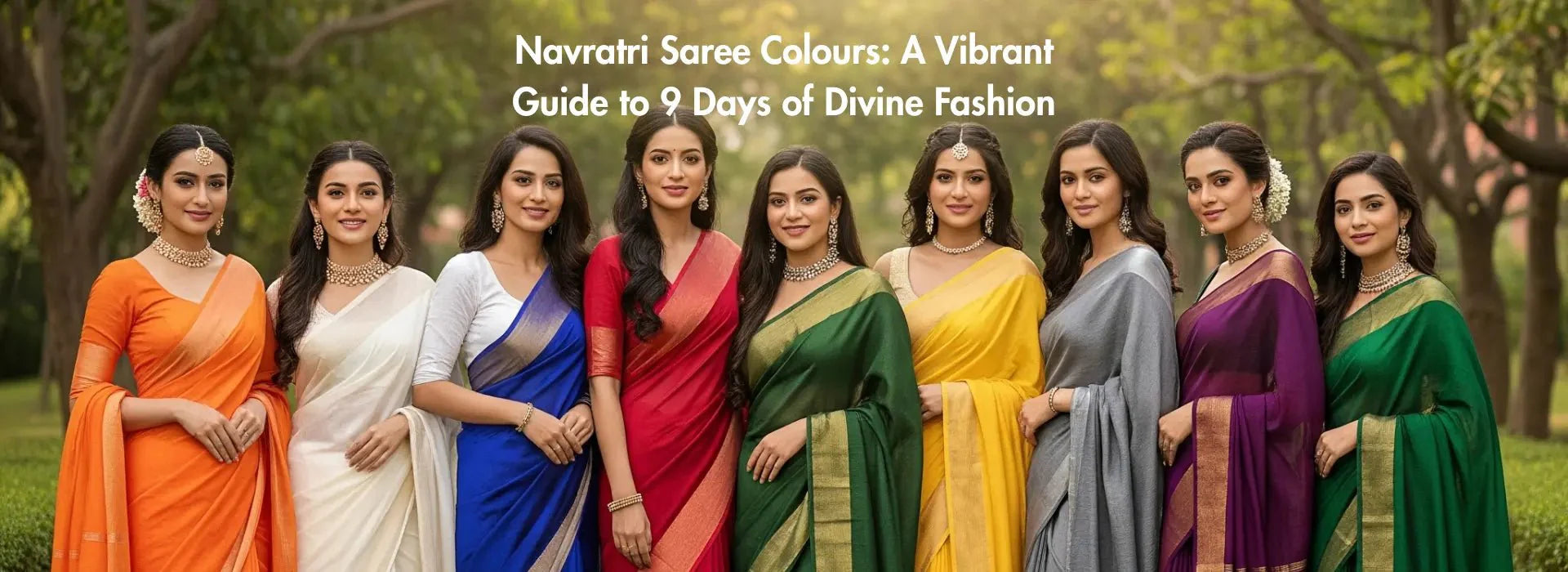Table of Contents
Navratri is not just a religious celebration in India; it is a cultural phenomenon that blends devotion with vibrant fashion. Across nine days, each day is dedicated to a different form of Goddess Durga and associated with a specific colour. These colours hold deep spiritual significance and have inspired traditional saree choices across generations.
The Significance of Navratri Saree Colours Each of the nine colours worn during Navratri is symbolic of the goddess honoured on that day. These colours are not chosen randomly; they represent specific qualities such as strength, purity, and devotion. Wearing sarees in these colours during Navratri is a form of spiritual and cultural expression observed by women across India.
Day-Wise Navratri Saree Colours and Meanings.
Day 1 - Royal Blue symbolises divine energy and calmness. It is worn to invoke the power and tranquillity of the goddess Shailputri.
A royal blue silk or cotton saree with minimalistic borders offers a dignified look for the first day.

Day 2 - Red represents strength and passion. It is associated with the goddess Brahmacharini.
Traditional red Banarasi sarees or pure georgette sarees with zari work are ideal choices for this day.
Day 3 - Yellow signifies joy and brightness. This colour reflects the energy of Chandraghanta.
Sarees made from handloom cotton or Chanderi in shades of yellow work well to capture the spirit of this day.
Day 4 - Green denotes renewal, nature, and growth. It is connected to the goddess Kushmanda.
Choose a green Kanjeevaram or linen saree for a balance of tradition and elegance.
Day 5 - Grey symbolises balance and composure. It is associated with the goddess Skandamata.
Grey silk or satin sarees can reflect a calm yet powerful presence.
Day 6 - Orange represents enthusiasm and determination. This colour honours the goddess Katyayani.
Maheshwari or Kota silk sarees in bright orange are suitable for this day.
Day 7 - White stands for purity, peace, and innocence. It is the colour of the goddess Kalratri.
White Jamdani or soft cotton sarees are best suited for expressing simplicity and serenity.
Day 8 - Pink reflects compassion and universal love. It honours the goddess Mahagauri.
Light pink handloom sarees or pastel silk sarees help maintain a graceful and composed appearance.
Day 9 - Sky Blue signifies clarity and vastness. This colour represents the goddess Siddhidatri.
Choose sky blue linen or organza sarees for a refreshing and modern take on tradition.
Styling Tips for Navratri Sarees.
1. Contrast or brocade blouses add festive charm to solid-colour sarees. Embellished blouses can elevate simple sarees to occasion-ready outfits.
2. Accessorising with Purpose Oxidised silver jewellery, temple-style ornaments, and colourful bangles enhance the festive look. Traditional bindis and potli bags complete the outfit.
3. Saree Fabric Considerations : Lightweight fabrics such as cotton, organza, and silk blends ensure comfort during long celebrations. Choose breathable textiles if you plan to attend garba or dandiya nights.
Regional Variations in Navratri Saree Traditions.
While the nine colours are followed across India, different states add unique elements. In Gujarat and Maharashtra, women wear traditional ghagra-sarees and nauvari sarees. In Tamil Nadu and Karnataka, silk sarees are preferred with intricate temple jewellery.
Navratri saree colours represent more than fashion. They reflect a spiritual journey through nine forms of the divine feminine. Wearing these colours with intention is a celebration of tradition, identity, and cultural unity. As Indian women continue to blend heritage with modern style, the saree remains a timeless symbol of grace and devotion.
Celebrate this Navratri with sarees that honour tradition and express individuality. Whether you choose classic silk or contemporary cotton, your Navratri saree can embody both style and spiritual significance.


